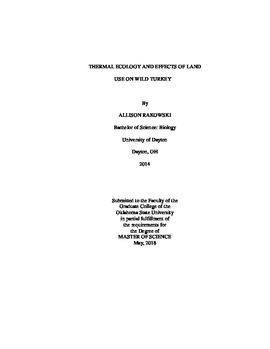| dc.contributor.advisor | Elmore, R. Dwayne | |
| dc.contributor.author | Rakowski, Allison | |
| dc.date.accessioned | 2019-05-08T18:36:48Z | |
| dc.date.available | 2019-05-08T18:36:48Z | |
| dc.date.issued | 2018-05-01 | |
| dc.identifier.uri | https://hdl.handle.net/11244/319619 | |
| dc.description.abstract | Wildlife are influenced by their surroundings and capable of making choices and selecting areas that provide habitat. We investigated habitat selection on several scales to determine what influences Rio Grande wild turkey (Meleagris gallopavo intermedia; hereafter wild turkey) space use and movement. On a fine scale we sought to describe the thermal landscape to determine how landscape features such as vegetation can be used to moderate thermal extremes. We captured and fitted 36 female wild turkey with GPS transmitters. We measured black bulb temperature (surrogate for operative temperature) and identified vegetation characteristics at wild turkey GPS locations and random landscape locations. We observed that the thermal landscape was highly heterogeneous with temperatures ranging up to 52 °C at a given ambient temperature. Vegetation type strongly influenced temperature across spatial scales, with taller vegetation types having mean temperatures up to 8.95 °C cooler than the remainder of the landscape. However, these cooler vegetation types were uncommon, only making up 8.2% of the landscape. Despite the rarity of tall vegetation, wild turkey showed strong selection for this vegetation type. Wild turkey also altered their movement in response to temperature. We found that on the hottest days (≥35 °C), wild turkeys decreased movement by three fold during peak heating, while movement on cooler days (<30 °C) was consistent throughout the day until the final locations. Collectively, our data provide evidence that space use on different scales and movement can be influenced by the thermal environment. In addition, we also examined broad scale habitat selection in terms of land cover (vegetation) and land use (management practices and energy development). Oil/gas wells were avoided in both the breeding and non-breeding seasons, while high traffic roads were avoided and low traffic roads were selected for in the breeding season. However, forest vegetation was by far the most influential factor in space use of wild turkey throughout the year. Therefore, our data collectively indicate that vegetation type, especially forest vegetation is the primary driver of wild turkey space use in terms of the thermal environment and land cover use. | |
| dc.format | application/pdf | |
| dc.language | en_US | |
| dc.rights | Copyright is held by the author who has granted the Oklahoma State University Library the non-exclusive right to share this material in its institutional repository. Contact Digital Library Services at lib-dls@okstate.edu or 405-744-9161 for the permission policy on the use, reproduction or distribution of this material. | |
| dc.title | Thermal Ecology and Effects of Land Use on Wild Turkey | |
| dc.contributor.committeeMember | Davis, Craig A. | |
| dc.contributor.committeeMember | Fuhlendorf, Samuel Dean | |
| osu.filename | Rakowski_okstate_0664M_15763.pdf | |
| osu.accesstype | Open Access | |
| dc.description.department | Natural Resource Ecology and Management | |
| dc.type.genre | Thesis | |
| dc.type.material | Text | |
